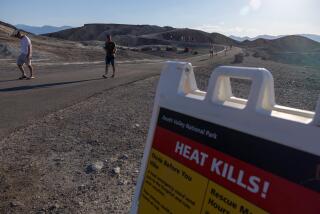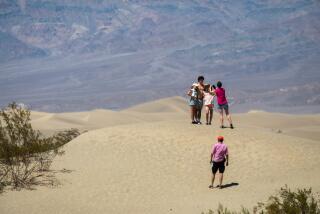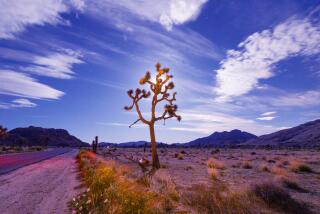Death Valley: A different kind of winter wonderland
In the summer, the sun in Death Valley shows no mercy, pushing the mercury over the 115-degree mark, sucking every drop of moisture from the earth and air. It is a cruel dictator.
Winter then stages a coup. Daytime highs average in the 80s, nighttime lows in the 30s. Life returns to the 3-million-acre national park, and visitors will find a flourishing golf course, horseback rides, Jeep rentals, hiking, swimming pools and the historic and highly regarded 1930s-style Furnace Creek Inn.
As an added prize, the 5,270 square miles of Death Valley serve up some amazing sunrises and sunsets in winter. The sunrises are so spectacular that visitors — including my partner, Gloria Cortes, and I — roll out of warm beds in the predawn hours to stand in the dark as the rays of the rising sun begin to paint the desert and its scenery in rainbow hues.
Sunsets are equally awesome and have the advantage, in winter, of an early show: The sun’s descent behind the Panamint Mountains begins in late afternoon, and the final glimmer fades away well before dinnertime.
Our first morning in the park last month found us bracing ourselves against a cold breeze that blew across Zabriskie Point, one of Death Valley’s best-known landmarks. You may recognize the name from a 1970 movie of the same name. That’s far from Death Valley’s only turn on the screen; more than 100 movies have been shot in Death Valley, including parts of the “Star Wars” series. It also was the foundation for the popular 1950s television series “Death Valley Days,” hosted for a time by Ronald Reagan.
Photography is one of the real draws at this time of year. Because the sun is at a lower angle now, you avoid the hot overhead light encountered at other times of the year. As a result, the winter months become a special time for photography workshops. If you see half a dozen or more people lined up with tripods at one of many scenic locations, it is a pretty good bet that a workshop is underway.
“Photography is all about interesting skies,” said Gary Hart, who leads a well-regarded photo workshop. “Doing it in Death Valley in the winter maximizes the odds of getting something interesting. I also love shooting the dunes, especially with no footprints. The opportunity to be creative with curves and lines is great.”
Ah, yes. The dunes. The Mesquite Dunes are near the small resort area of Stovepipe Wells on the eastern side of the park. The wind shapes the sand into a variety of curves, lines and shadows that just beg to be photographed.
The afternoon we arrived we stayed in the dunes shooting the sunset and the moonrise until it got dark. The next evening, the wind came up and performed its magic, wiping out the hundreds of footprints scattered across the sand. When we returned at sunrise, we found dunes so pristine that they looked as though no human ever had crossed them.
One of the great park landmarks is Manly Beacon, which sits near the top of Golden Canyon and is visible from Zabriskie Point. It is named after William Manly, one of the two men who spearheaded the rescue of some stranded pioneers in an 1849-50 crossing of the valley. Manly and his companion, John Rogers, walked 300 miles and returned with supplies for the travelers, only one of whom died while waiting for the men.
It also marks the starting point for one of the scenic hiking trails in the park. There are two options. You can do the hike as a round trip — three miles each way — or leave a second car at one end to serve as a shuttle. We met up with David Woodruff, park staffer and avid hiker, and with his help, had a car at both ends of the trail. We hiked from the top of Golden Canyon down to the lower entrance. He told us that one of the keys to enjoyment for him is “the size and vastness of the park. Its sheer immensity provides so many opportunities for exploring.” For us, Golden Canyon provided a series of “oohs” and “aaahs” around almost every bend.
Mosaic Canyon, just outside of Stovepipe Wells, provides another noteworthy hike. A two-mile drive up a gravel road takes you to the trailhead parking for this nine-mile-long canyon. The walls are a mosaic of pink, white, brown and black and are especially pretty after a light rainfall. If you are lucky, you may spot one of the desert bighorn sheep that frequent the canyon’s ridges.
For many visitors, one of the main stops is Scotty’s Castle, built in the 1920s by former mule team swamper (swampers gathered firewood, washed dishes and tended the mules) Walter Scott at a cost of $2 million. Scotty, who was quite a story teller, claimed he financed the architectural masterpiece with gold from a fabulous secret mine in Death Valley. No one has found such a mine. Historians think the real source of the construction money came from Scotty’s good friend financier Albert Johnson. Whatever the source of the money, the result is remarkable and well worth the visit. Guided tours also are available.
Late afternoon is a good time to visit two other popular locations. More than 300 years ago, a volcanic explosion blasted out a crater 600 feet deep. The afternoon sun lights up the walls of the Ubehebe Crater, about nine miles from Scotty’s Castle.
The afternoon sun also works its magic in the popular Artists Palette in the central part of Death Valley. You can see splashes of red, black, green, yellow, violet, brown and pink, which spring from rock formations containing iron oxides, copper and mica. The surrounding area also glows a rich and inviting gold in the late afternoon sun that is jaw-dropping in its intensity. We repeatedly stopped the car to take photos.
The park gets less than a million visitors a year, but that number is increasing. Phil Dickinson, a 13-year director at Furnace Creek Resort, said: “I am a great believer that most people who come here for the first time invariably want to come back. They say, ‘Wow. This is not what we thought, and we want to spend more time here.’”
On our last morning in the park, we struck up a conversation with a couple who had arrived from New Jersey. We had returned to Zabriskie Point to see one more sunrise and, on the spot, the couple decided to rework their vacation itinerary so they could stay here longer. Hope they had plenty of memory cards for all the great pictures.
More to Read
Sign up for The Wild
We’ll help you find the best places to hike, bike and run, as well as the perfect silent spots for meditation and yoga.
You may occasionally receive promotional content from the Los Angeles Times.






